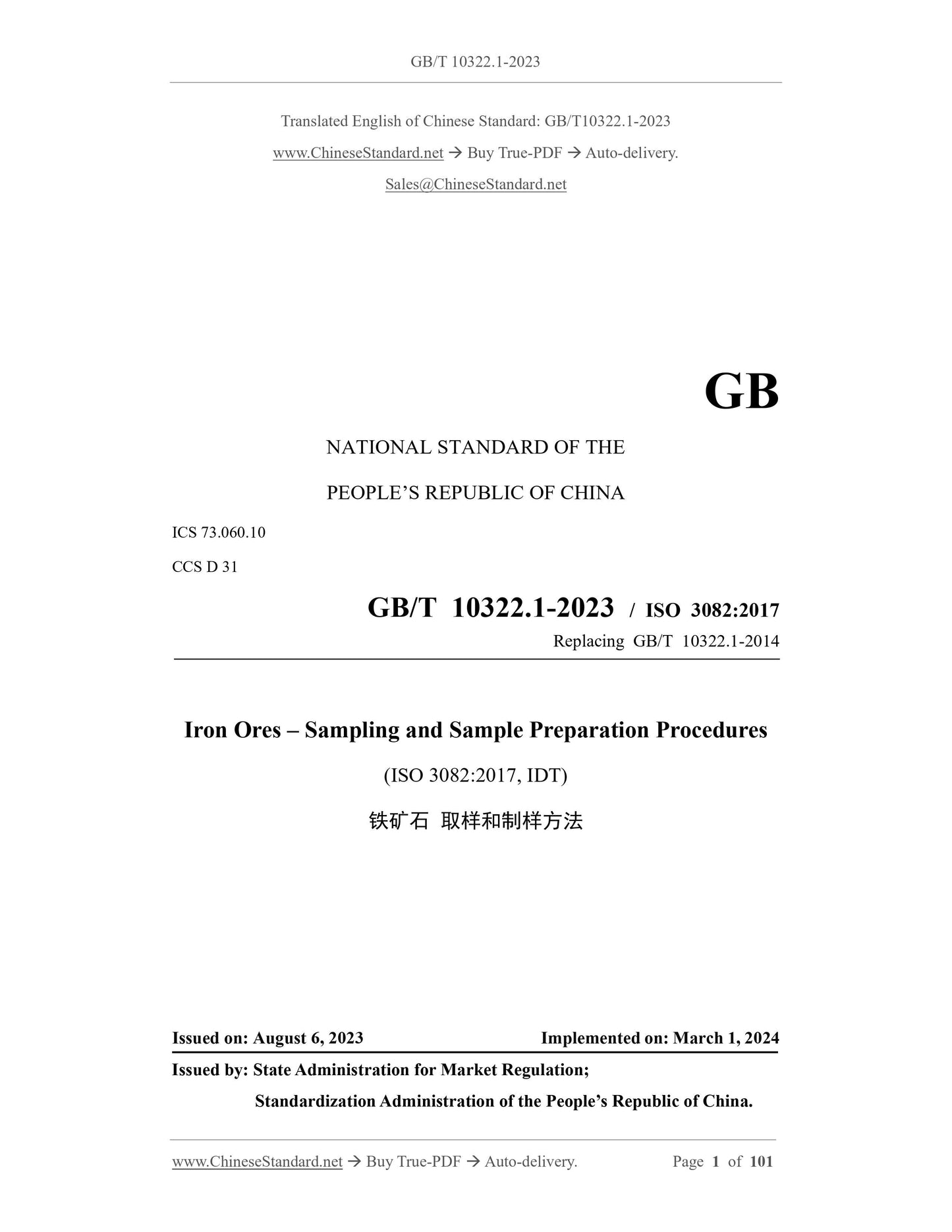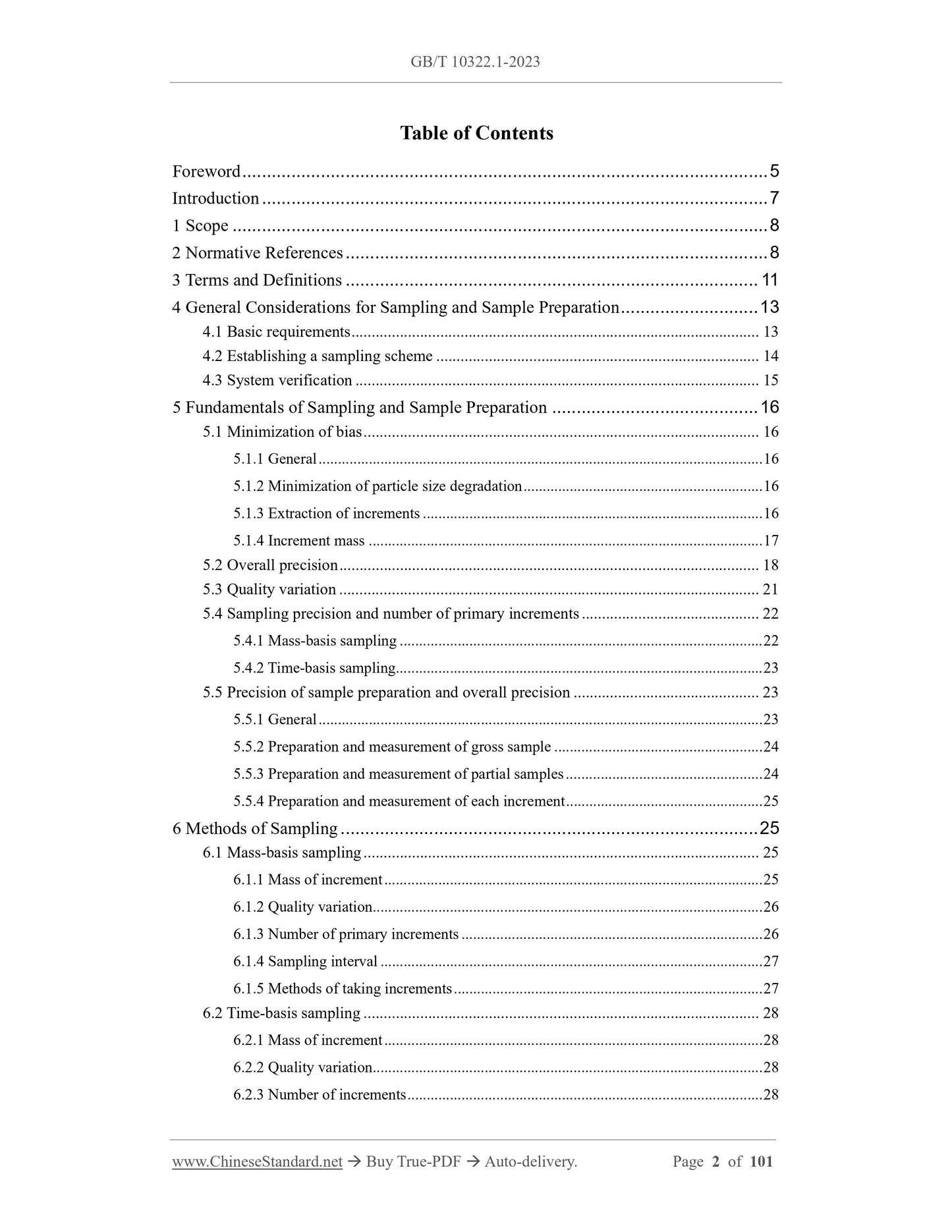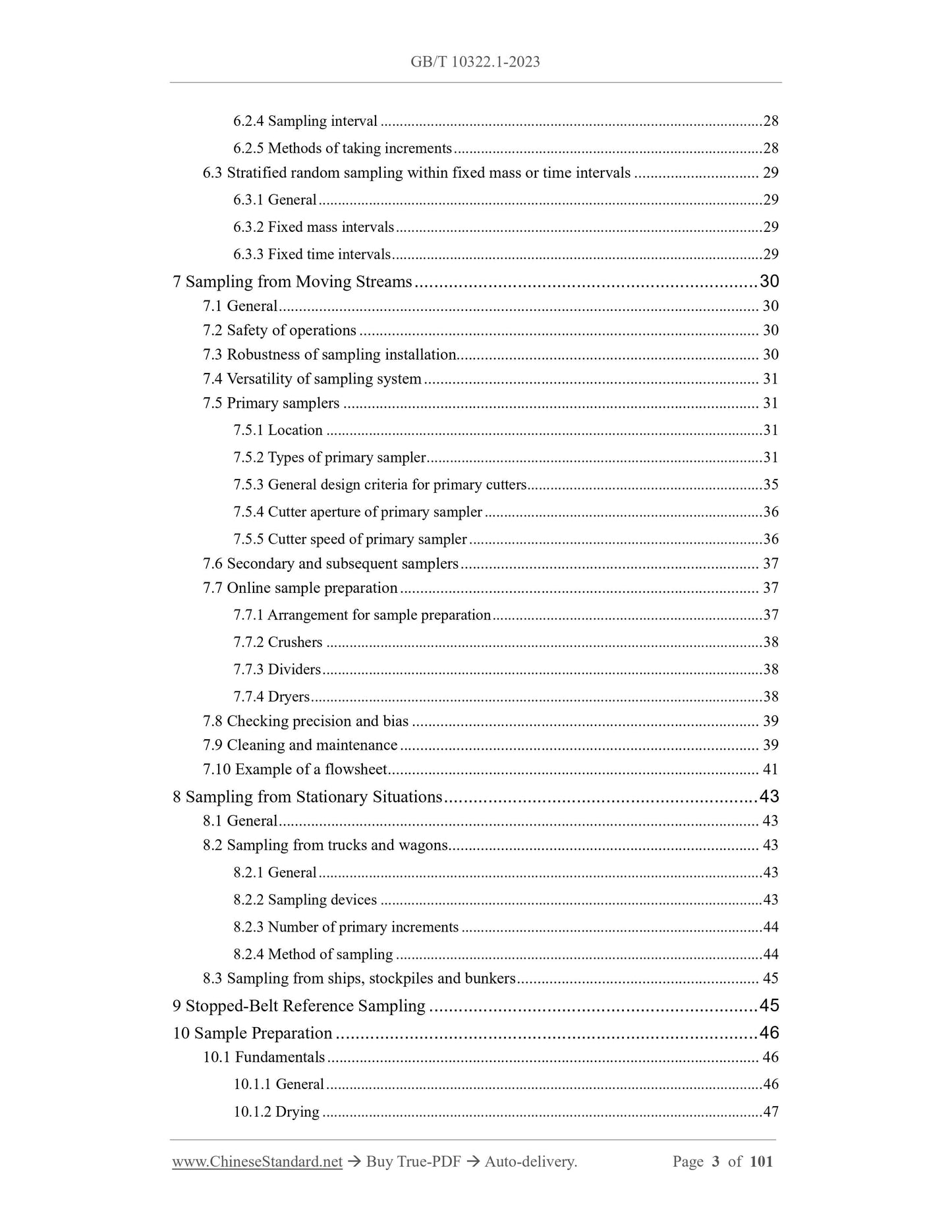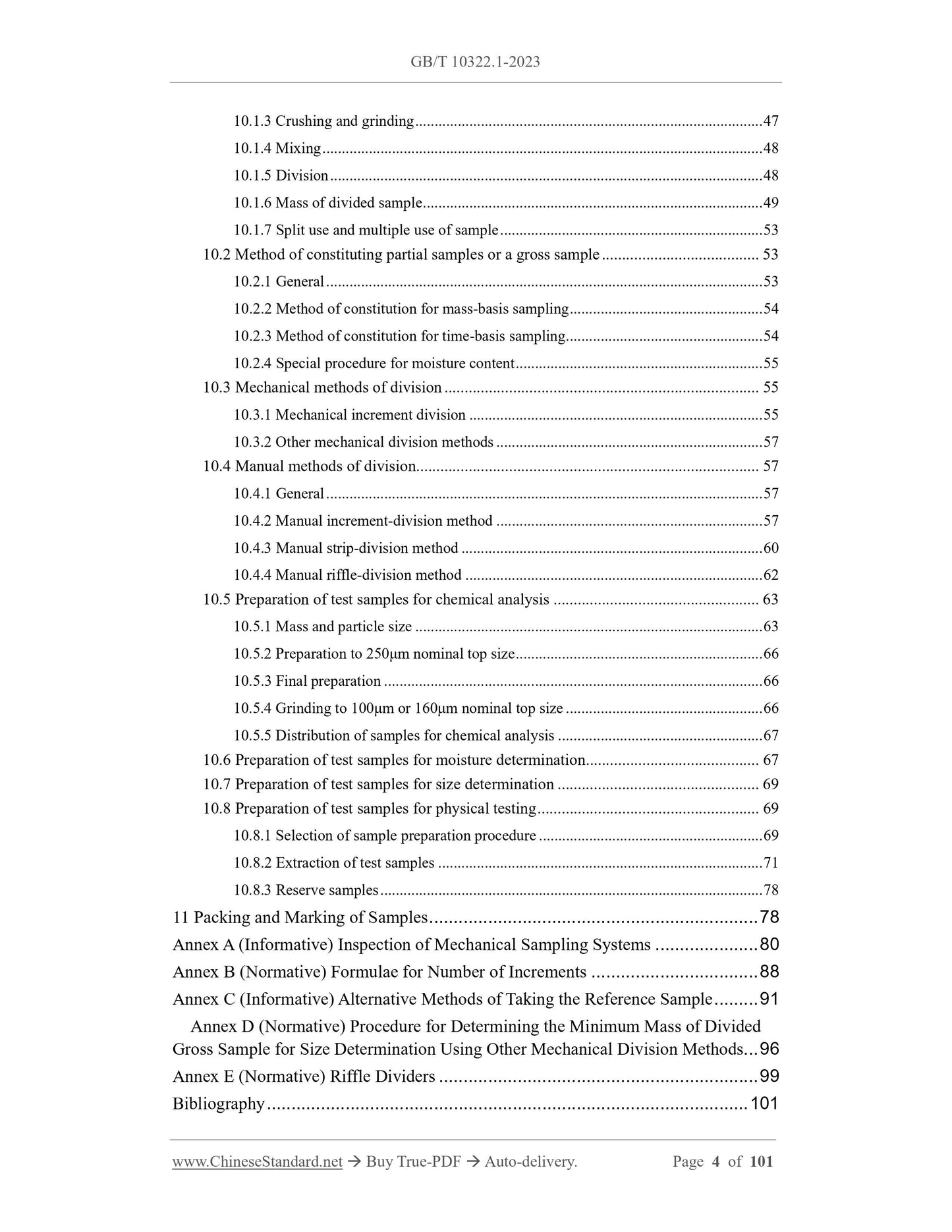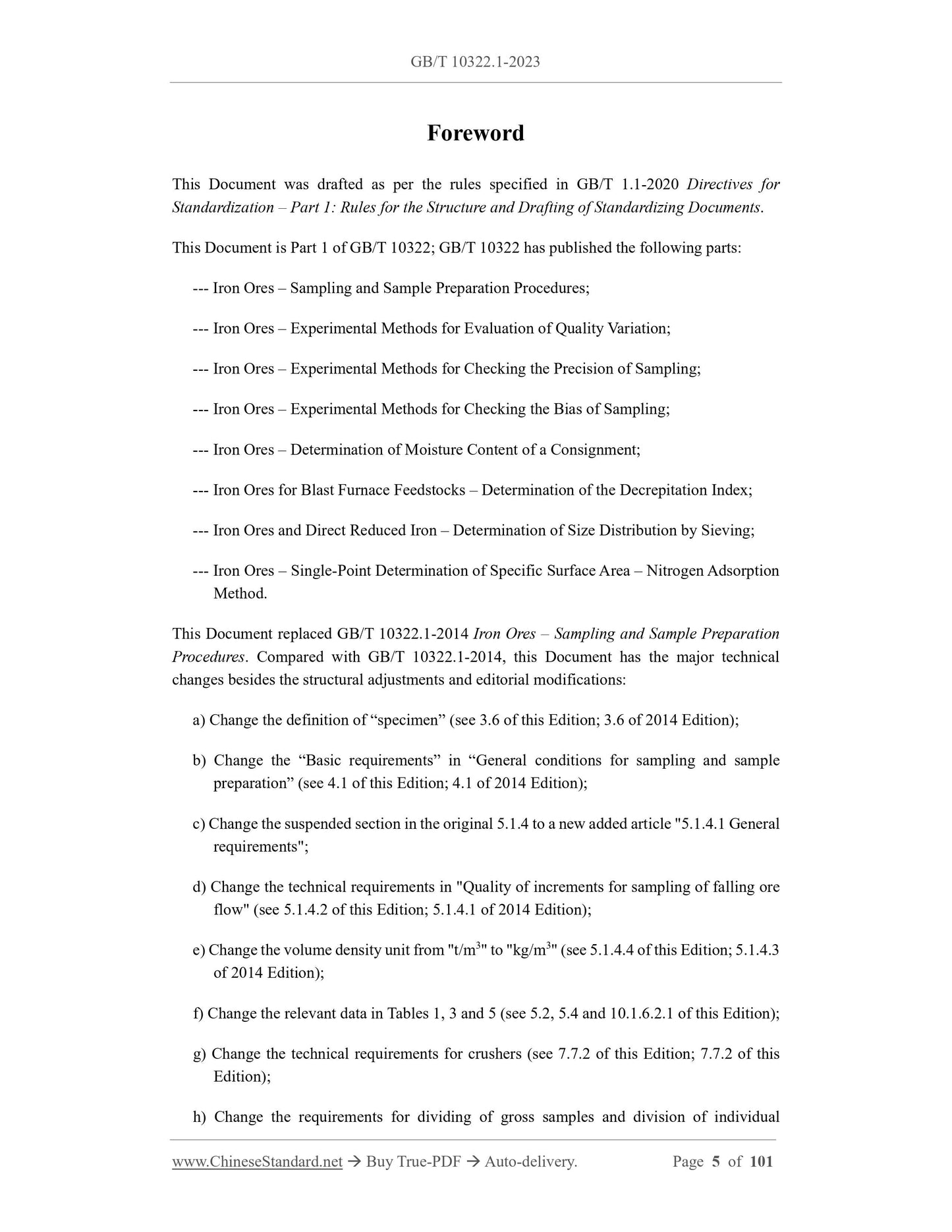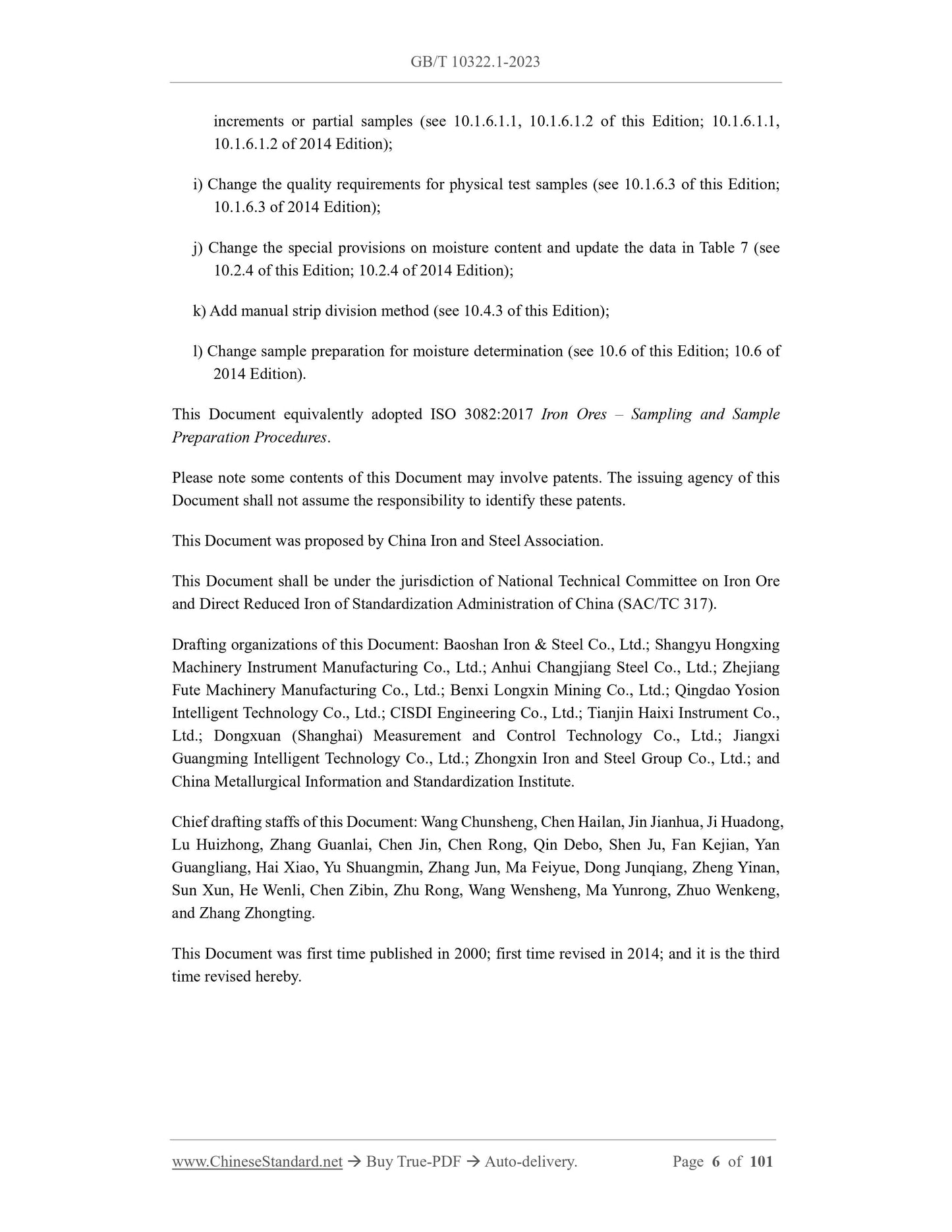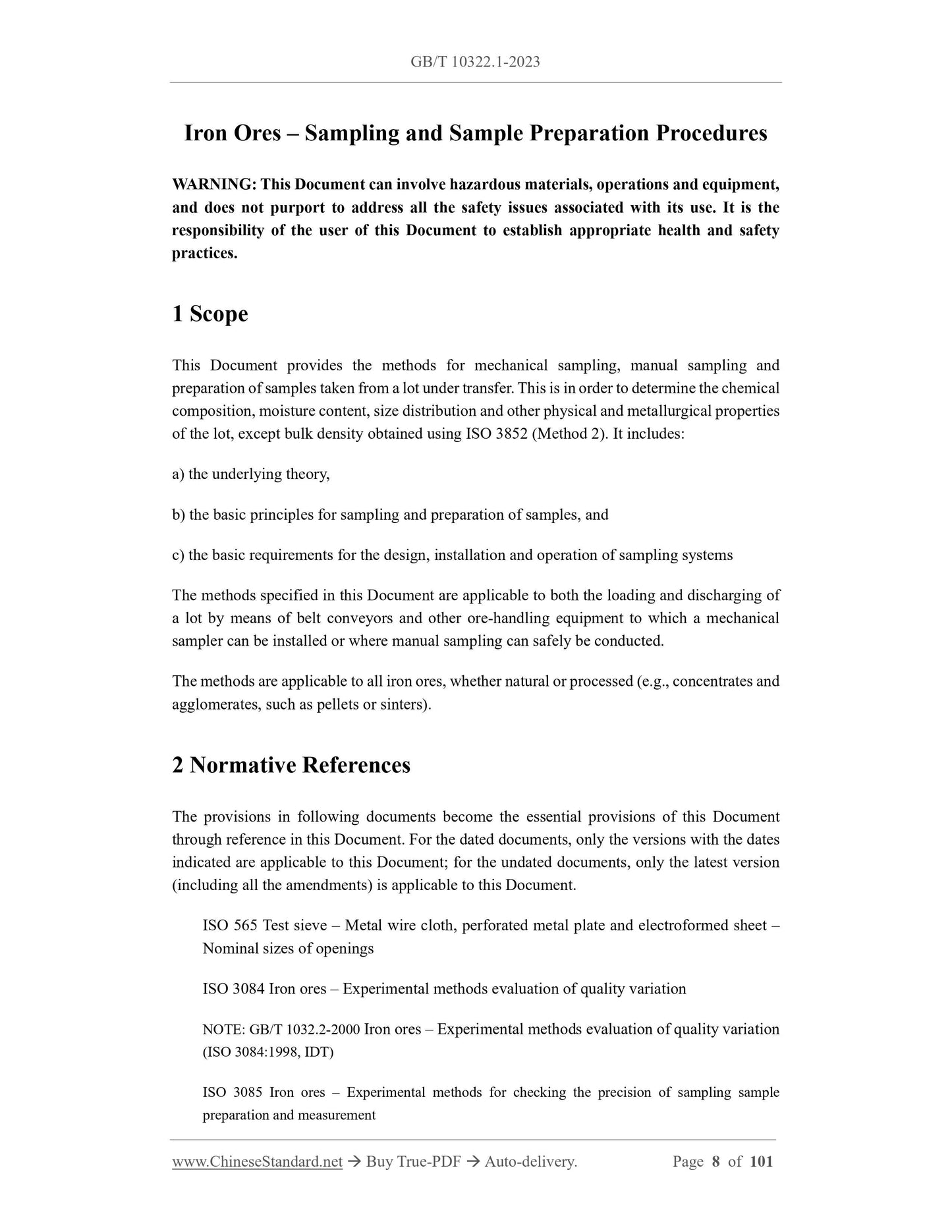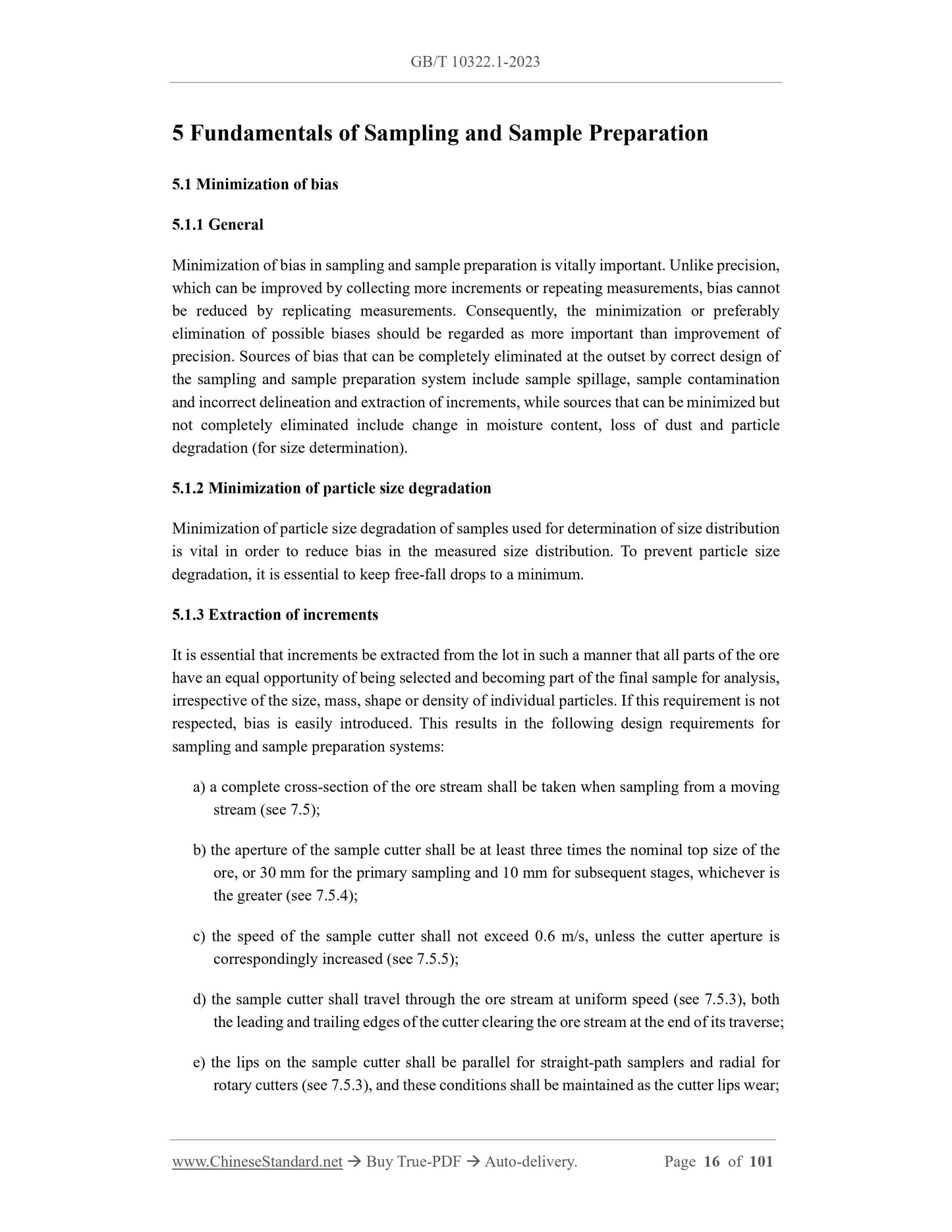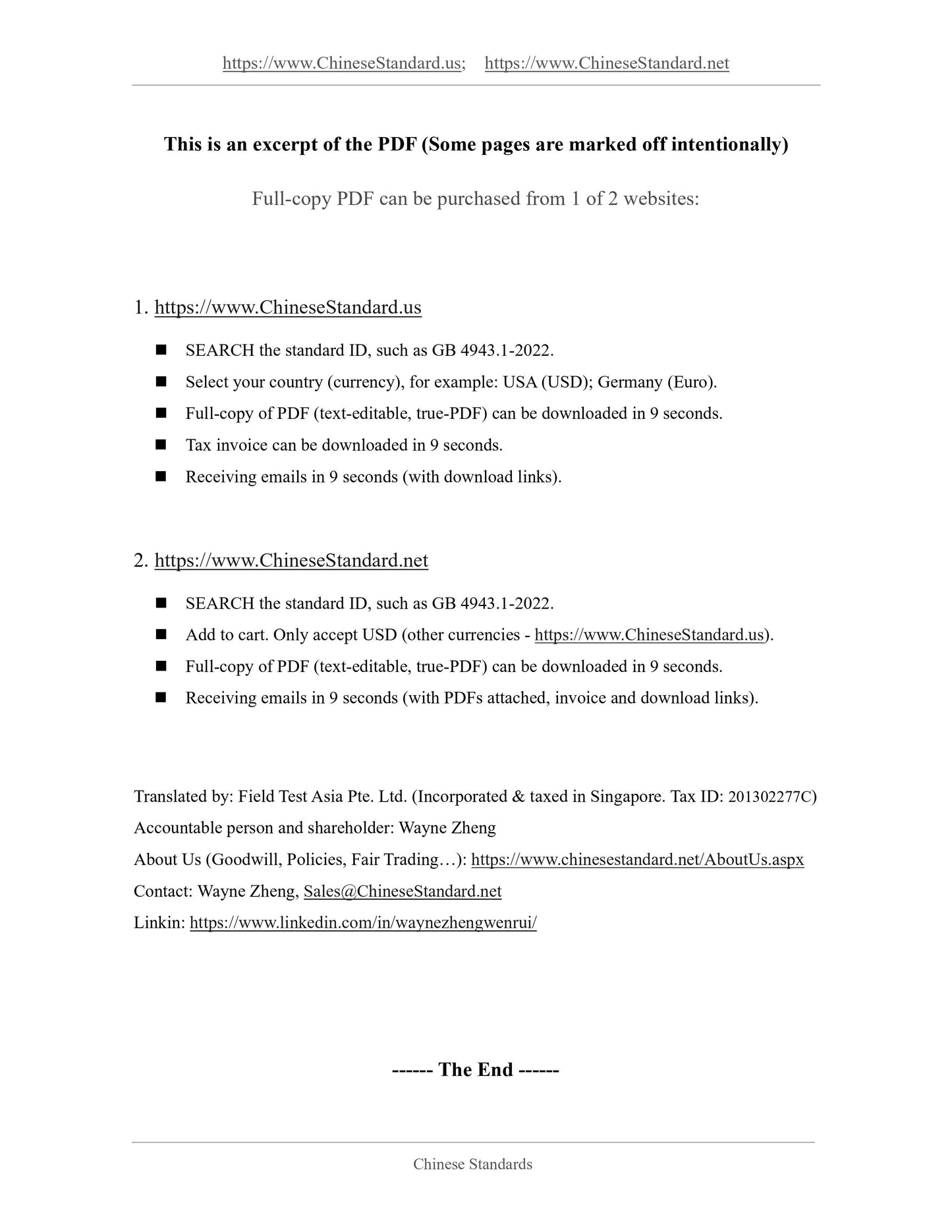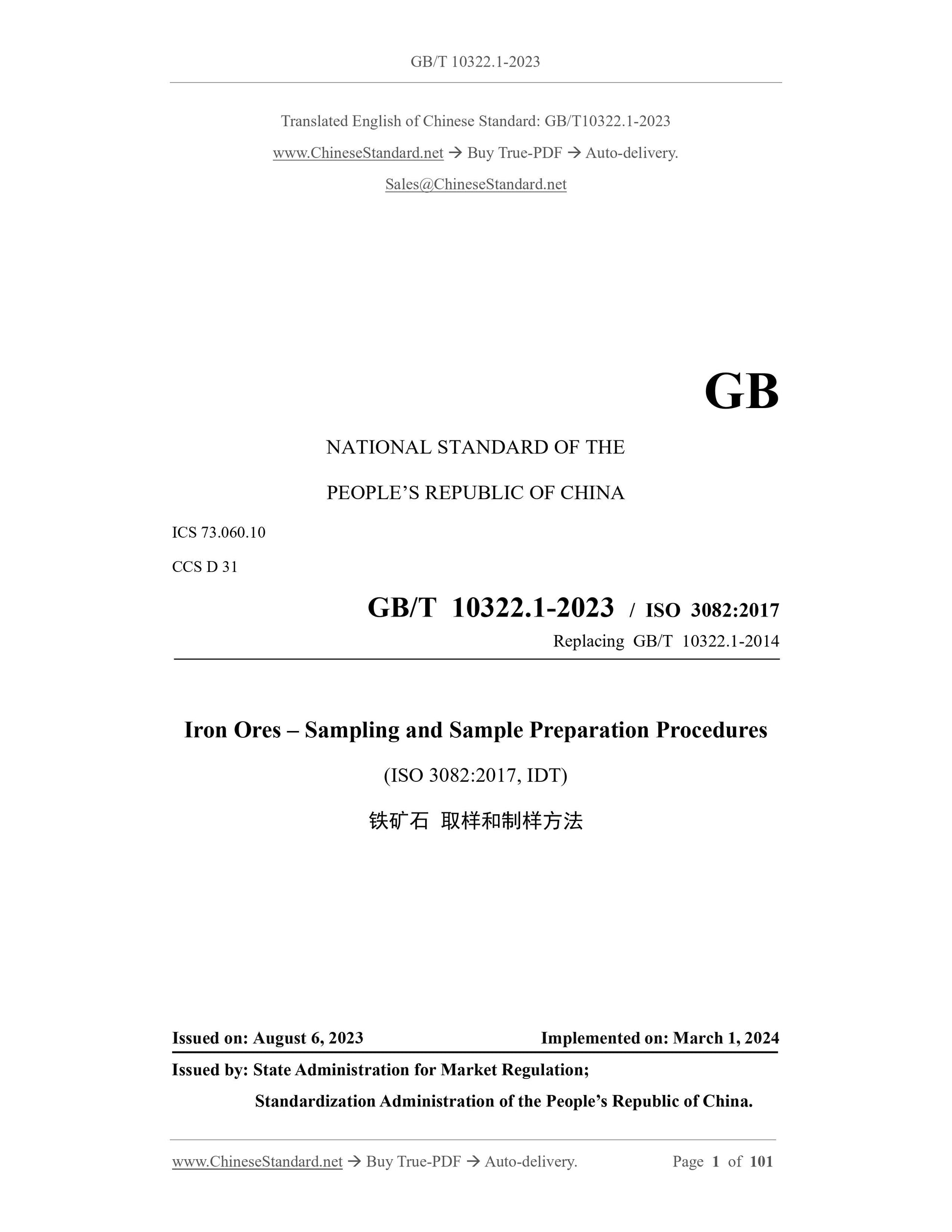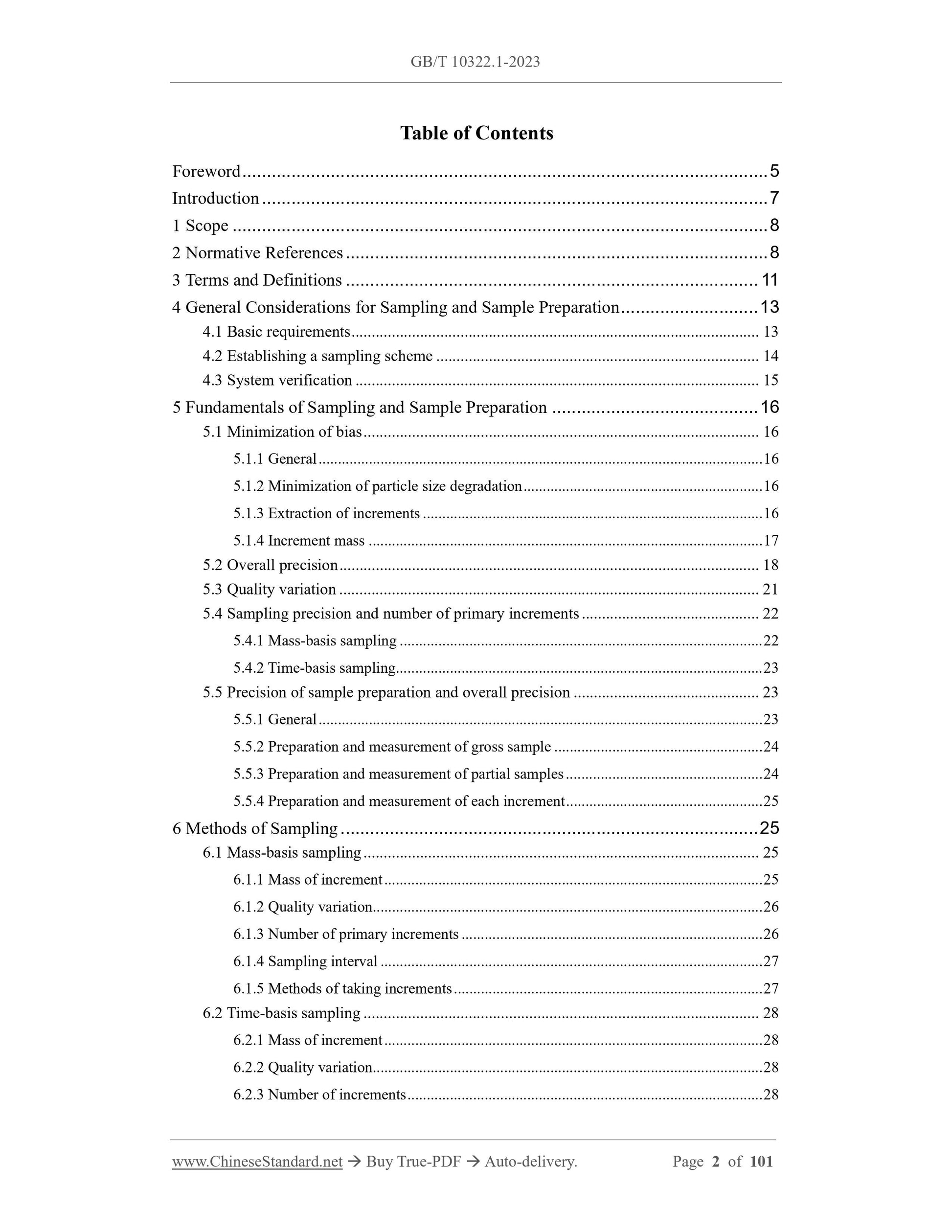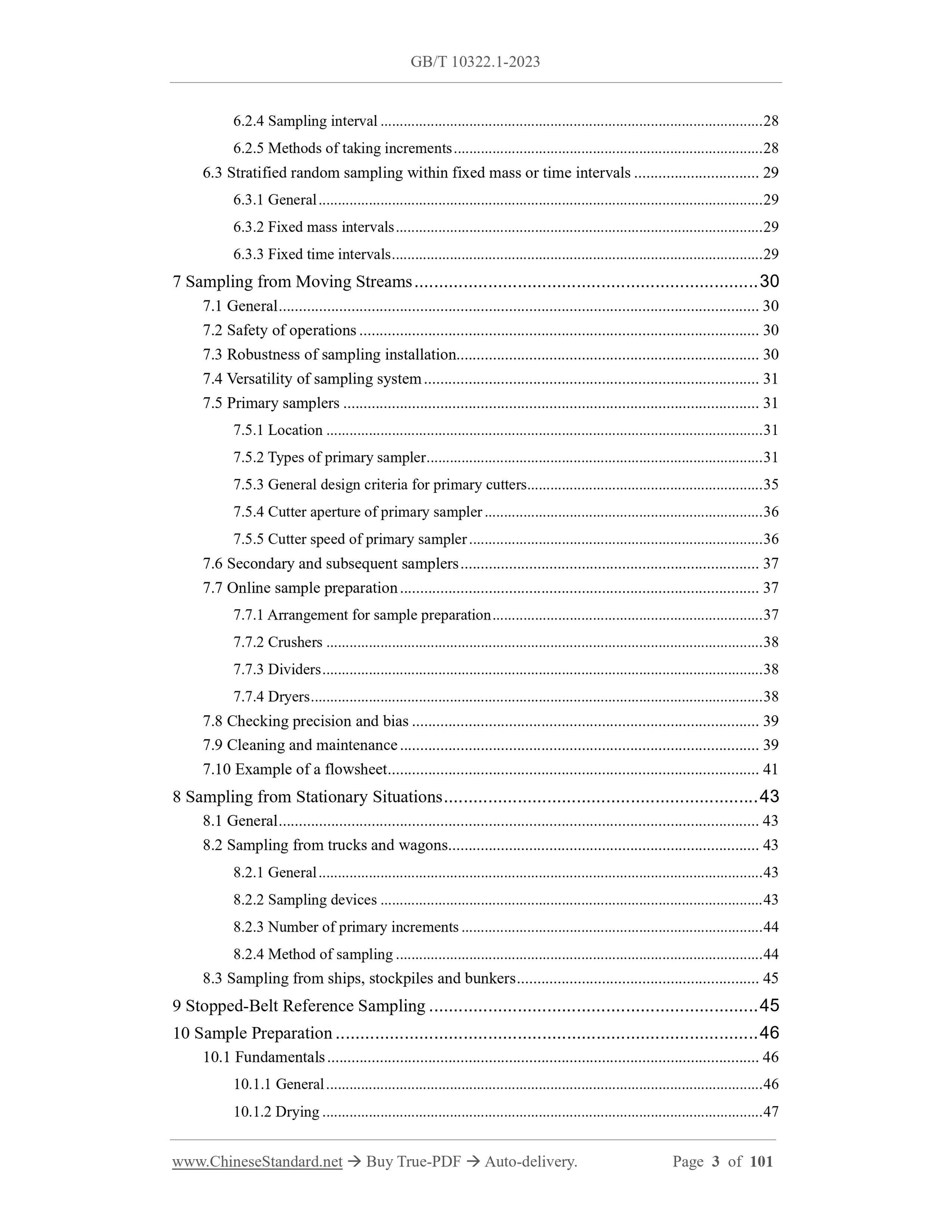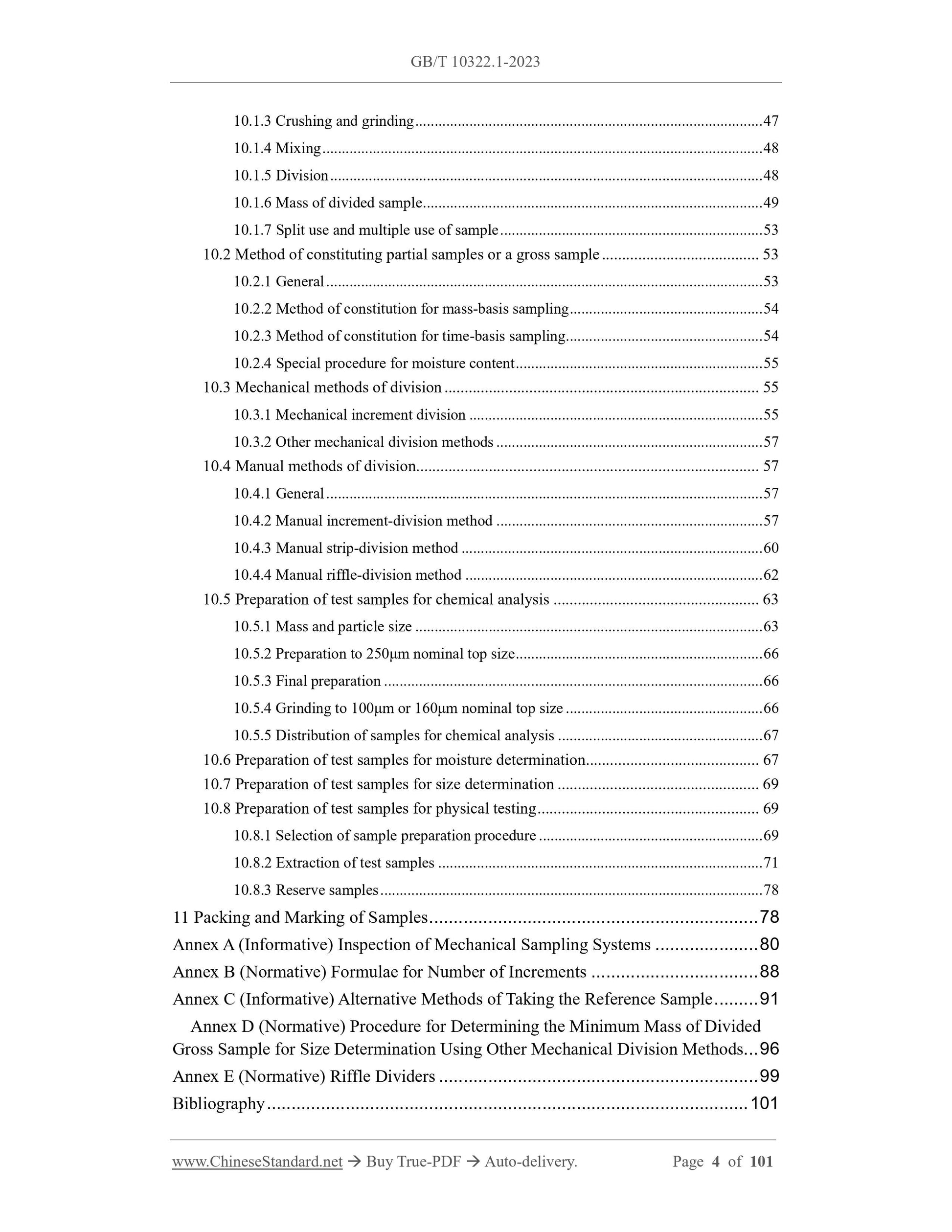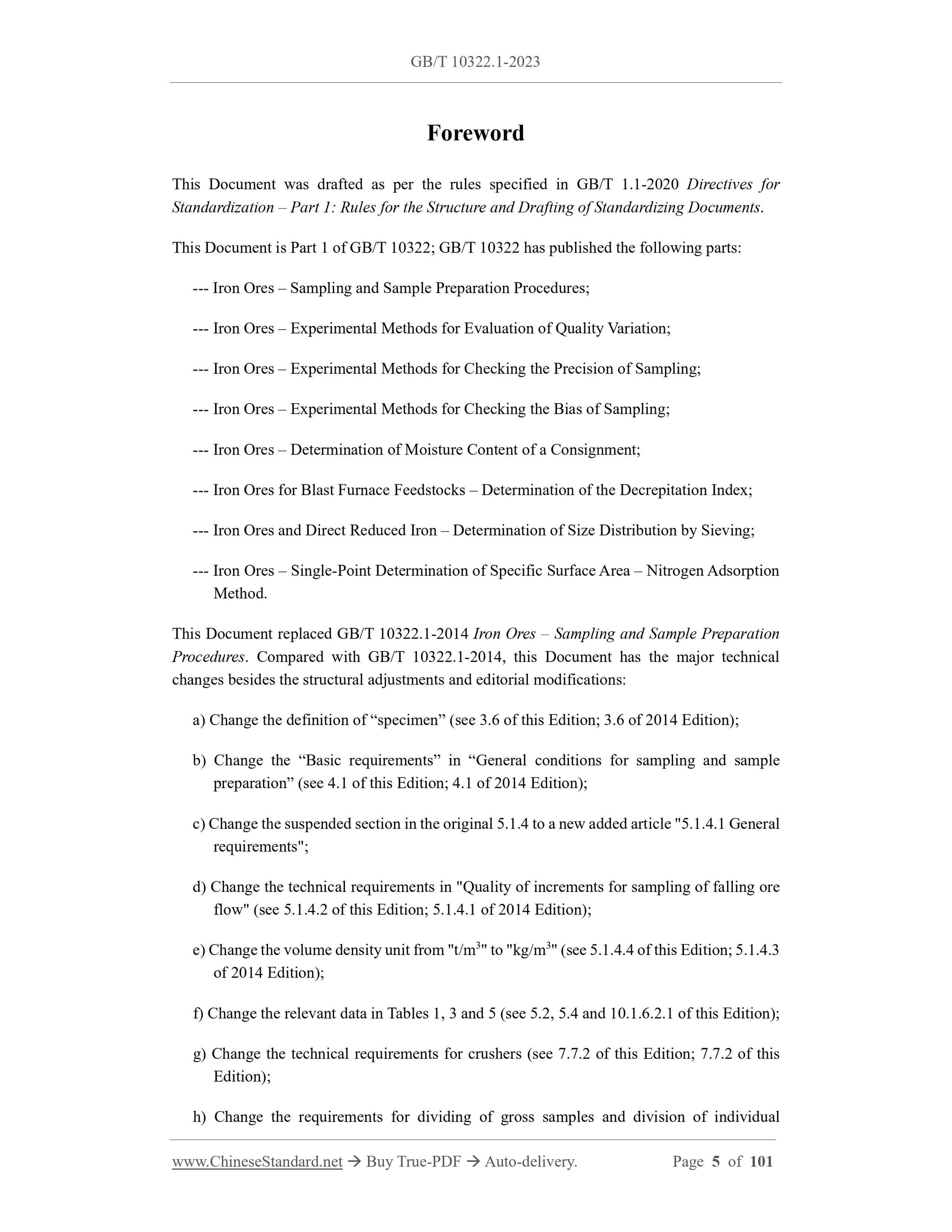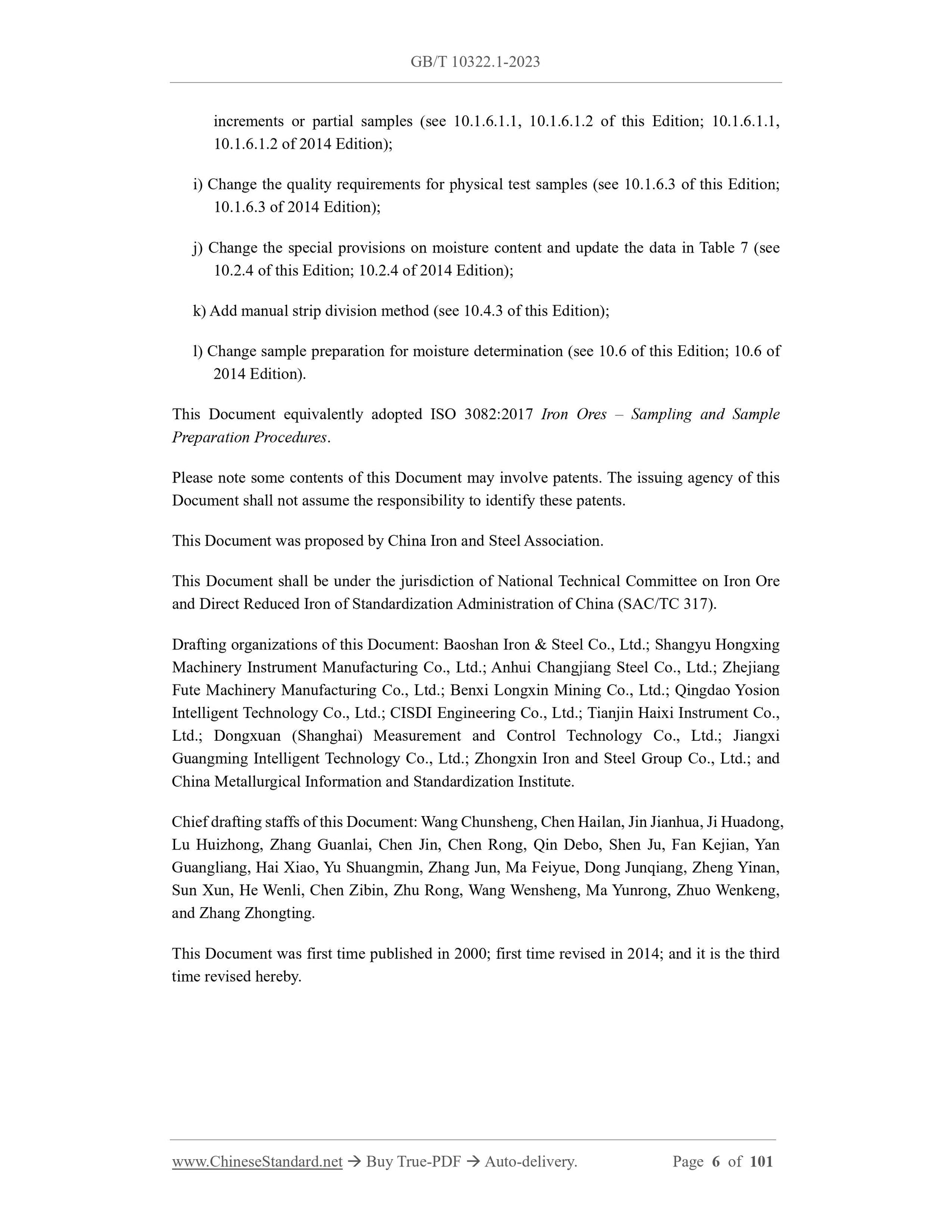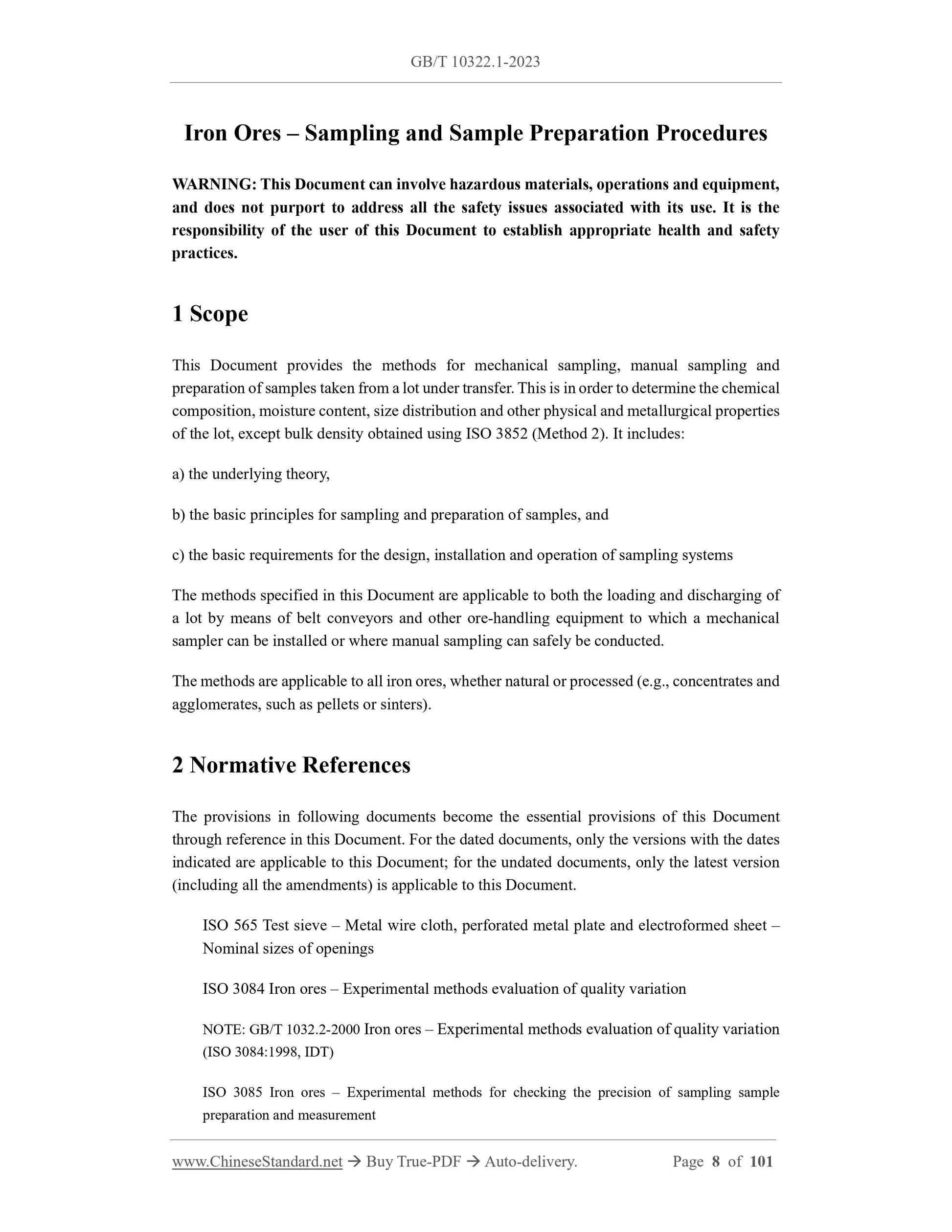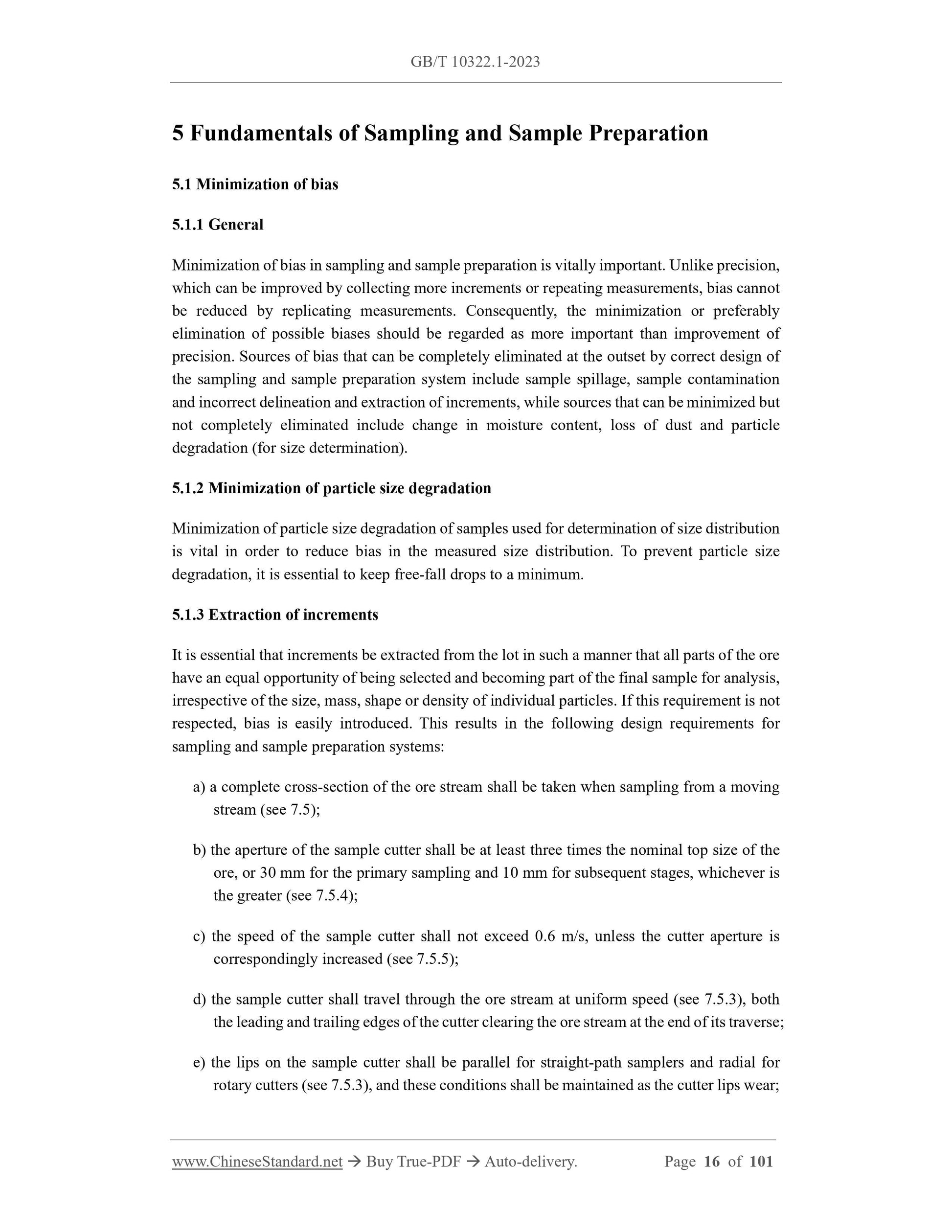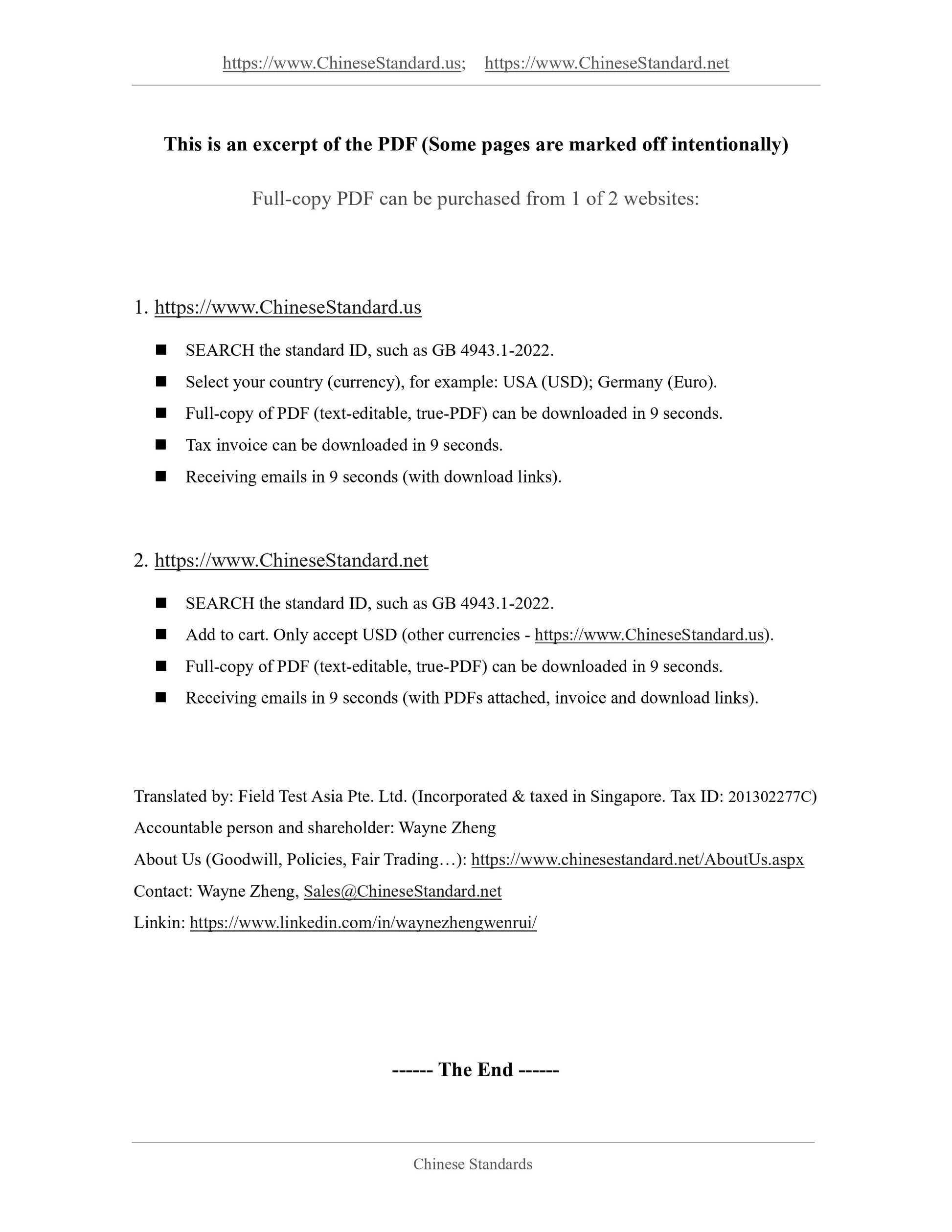1
/
su
9
PayPal, credit cards. Download editable-PDF and invoice in 1 second!
GB/T 10322.1-2023 English PDF (GBT10322.1-2023)
GB/T 10322.1-2023 English PDF (GBT10322.1-2023)
Prezzo di listino
$1,205.00 USD
Prezzo di listino
Prezzo scontato
$1,205.00 USD
Prezzo unitario
/
per
Spese di spedizione calcolate al check-out.
Impossibile caricare la disponibilità di ritiro
Delivery: 3 seconds. Download true-PDF + Invoice.
Get QUOTATION in 1-minute: Click GB/T 10322.1-2023
Historical versions: GB/T 10322.1-2023
Preview True-PDF (Reload/Scroll if blank)
GB/T 10322.1-2023: Iron ores - Sampling and sample preparation procedures
GB/T 10322.1-2023
GB
NATIONAL STANDARD OF THE
PEOPLE’S REPUBLIC OF CHINA
ICS 73.060.10
CCS D 31
GB/T 10322.1-2023 / ISO 3082:2017
Replacing GB/T 10322.1-2014
Iron Ores – Sampling and Sample Preparation Procedures
(ISO 3082:2017, IDT)
ISSUED ON: AUGUST 6, 2023
IMPLEMENTED ON: MARCH 1, 2024
Issued by: State Administration for Market Regulation;
Standardization Administration of the People’s Republic of China.
Table of Contents
Foreword ... 5
Introduction ... 7
1 Scope ... 8
2 Normative References ... 8
3 Terms and Definitions ... 11
4 General Considerations for Sampling and Sample Preparation ... 13
4.1 Basic requirements ... 13
4.2 Establishing a sampling scheme ... 14
4.3 System verification ... 15
5 Fundamentals of Sampling and Sample Preparation ... 16
5.1 Minimization of bias ... 16
5.1.1 General ... 16
5.1.2 Minimization of particle size degradation ... 16
5.1.3 Extraction of increments ... 16
5.1.4 Increment mass ... 17
5.2 Overall precision ... 18
5.3 Quality variation ... 21
5.4 Sampling precision and number of primary increments ... 22
5.4.1 Mass-basis sampling ... 22
5.4.2 Time-basis sampling ... 23
5.5 Precision of sample preparation and overall precision ... 23
5.5.1 General ... 23
5.5.2 Preparation and measurement of gross sample ... 24
5.5.3 Preparation and measurement of partial samples ... 24
5.5.4 Preparation and measurement of each increment ... 25
6 Methods of Sampling ... 25
6.1 Mass-basis sampling ... 25
6.1.1 Mass of increment ... 25
6.1.2 Quality variation... 26
6.1.3 Number of primary increments ... 26
6.1.4 Sampling interval ... 27
6.1.5 Methods of taking increments ... 27
6.2 Time-basis sampling ... 28
6.2.1 Mass of increment ... 28
6.2.2 Quality variation... 28
6.2.3 Number of increments ... 28
6.2.4 Sampling interval ... 28
6.2.5 Methods of taking increments ... 28
6.3 Stratified random sampling within fixed mass or time intervals ... 29
6.3.1 General ... 29
6.3.2 Fixed mass intervals ... 29
6.3.3 Fixed time intervals ... 29
7 Sampling from Moving Streams ... 30
7.1 General ... 30
7.2 Safety of operations ... 30
7.3 Robustness of sampling installation... 30
7.4 Versatility of sampling system ... 31
7.5 Primary samplers ... 31
7.5.1 Location ... 31
7.5.2 Types of primary sampler ... 31
7.5.3 General design criteria for primary cutters ... 35
7.5.4 Cutter aperture of primary sampler ... 36
7.5.5 Cutter speed of primary sampler ... 36
7.6 Secondary and subsequent samplers ... 37
7.7 Online sample preparation ... 37
7.7.1 Arrangement for sample preparation ... 37
7.7.2 Crushers ... 38
7.7.3 Dividers ... 38
7.7.4 Dryers ... 38
7.8 Checking precision and bias ... 39
7.9 Cleaning and maintenance ... 39
7.10 Example of a flowsheet ... 41
8 Sampling from Stationary Situations ... 43
8.1 General ... 43
8.2 Sampling from trucks and wagons ... 43
8.2.1 General ... 43
8.2.2 Sampling devices ... 43
8.2.3 Number of primary increments ... 44
8.2.4 Method of sampling ... 44
8.3 Sampling from ships, stockpiles and bunkers ... 45
9 Stopped-Belt Reference Sampling ... 45
10 Sample Preparation ... 46
10.1 Fundamentals ... 46
10.1.1 General ... 46
10.1.2 Drying ... 47
10.1.3 Crushing and grinding ... 47
10.1.4 Mixing ... 48
10.1.5 Division ... 48
10.1.6 Mass of divided sample ... 49
10.1.7 Split use and multiple use of sample ... 53
10.2 Method of constituting partial samples or a gross sample ... 53
10.2.1 General ... 53
10.2.2 Method of constitution for mass-basis sampling ... 54
10.2.3 Method of constitution for time-basis sampling ... 54
10.2.4 Special procedure for moisture content ... 55
10.3 Mechanical methods of division ... 55
10.3.1 Mechanical increment division ... 55
10.3.2 Other mechanical division methods ... 57
10.4 Manual methods of division... 57
10.4.1 General ... 57
10.4.2 Manual increment-division method ... 57
10.4.3 Manual strip-division method ... 60
10.4.4 Manual riffle-division method ... 62
10.5 Preparation of test samples for chemical analysis ... 63
10.5.1 Mass and particle size ... 63
10.5.2 Preparation to 250μm nominal top size ... 66
10.5.3 Final preparation ... 66
10.5.4 Grinding to 100μm or 160μm nominal top size ... 66
10.5.5 Distribution of samples for chemical analysis ... 67
10.6 Preparation of test samples for moisture determination ... 67
10.7 Preparation of test samples for size determination ... 69
10.8 Preparation of test samples for physical testing ... 69
10.8.1 Selection of sample preparation procedure ... 69
10.8.2 Extraction of test samples ... 71
10.8.3 Reserve samples ... 78
11 Packing and Marking of Samples ... 78
Annex A (Informative) Inspection of Mechanical Sampling Systems ... 80
Annex B (Normative) Formulae for Number of Increments ... 88
Annex C (Informative) Alternative Methods of Taking the Reference Sample ... 91
Annex D (Normative) Procedure for Determining the Minimum Mass of Divided
Gross Sample for Size Determination Using Other Mechanical Division Methods... 96
Annex E (Normative) Riffle Dividers ... 99
Bibliography ... 101
Foreword
This Document was drafted as per the rules specified in GB/T 1.1-2020 Directives for
Standardization – Part 1: Rules for the Structure and Drafting of Standardizing Documents.
This Document is Part 1 of GB/T 10322; GB/T 10322 has published the following parts:
--- Iron Ores – Sampling and Sample Preparation Procedures;
--- Iron Ores – Experimental Methods for Evaluation of Quality Variation;
--- Iron Ores – Experimental Methods for Checking the Precision of Sampling;
--- Iron Ores – Experimental Methods for Checking the Bias of Sampling;
--- Iron Ores – Determination of Moisture Content of a Consignment;
--- Iron Ores for Blast Furnace Feedstocks – Determination of the Decrepitation Index;
--- Iron Ores and Direct Reduced Iron – Determination of Size Distribution by Sieving;
--- Iron Ores – Single-Point Determination of Specific Surface Area – Nitrogen Adsorption
Method.
This Document replaced GB/T 10322.1-2014 Iron Ores – Sampling and Sample Preparation
Procedures. Compared with GB/T 10322.1-2014, this Document has the major technical
changes besides the structural adjustments and editorial modifications:
a) Change the definition of “specimen” (see 3.6 of this Edition; 3.6 of 2014 Edition);
b) Change the “Basic requirements” in “General conditions for sampling and sample
preparation” (see 4.1 of this Edition; 4.1 of 2014 Edition);
c) Change the suspended section in the original 5.1.4 to a new added article "5.1.4.1 General
requirements";
d) Change the technical requirements in "Quality of increments for sampling of falling ore
flow" (see 5.1.4.2 of this Edition; 5.1.4.1 of 2014 Edition);
e) Change the volume density unit from "t/m3" to "kg/m3" (see 5.1.4.4 of this Edition; 5.1.4.3
of 2014 Edition);
f) Change the relevant data in Tables 1, 3 and 5 (see 5.2, 5.4 and 10.1.6.2.1 of this Edition);
g) Change the technical requirements for crushers (see 7.7.2 of this Edition; 7.7.2 of this
Edition);
h) Change the requirements for dividing of gross samples and division of individual
increments or partial samples (see 10.1.6.1.1, 10.1.6.1.2 of this Edition; 10.1.6.1.1,
10.1.6.1.2 of 2014 Edition);
i) Change the quality requirements for physical test samples (see 10.1.6.3 of this E...
Get QUOTATION in 1-minute: Click GB/T 10322.1-2023
Historical versions: GB/T 10322.1-2023
Preview True-PDF (Reload/Scroll if blank)
GB/T 10322.1-2023: Iron ores - Sampling and sample preparation procedures
GB/T 10322.1-2023
GB
NATIONAL STANDARD OF THE
PEOPLE’S REPUBLIC OF CHINA
ICS 73.060.10
CCS D 31
GB/T 10322.1-2023 / ISO 3082:2017
Replacing GB/T 10322.1-2014
Iron Ores – Sampling and Sample Preparation Procedures
(ISO 3082:2017, IDT)
ISSUED ON: AUGUST 6, 2023
IMPLEMENTED ON: MARCH 1, 2024
Issued by: State Administration for Market Regulation;
Standardization Administration of the People’s Republic of China.
Table of Contents
Foreword ... 5
Introduction ... 7
1 Scope ... 8
2 Normative References ... 8
3 Terms and Definitions ... 11
4 General Considerations for Sampling and Sample Preparation ... 13
4.1 Basic requirements ... 13
4.2 Establishing a sampling scheme ... 14
4.3 System verification ... 15
5 Fundamentals of Sampling and Sample Preparation ... 16
5.1 Minimization of bias ... 16
5.1.1 General ... 16
5.1.2 Minimization of particle size degradation ... 16
5.1.3 Extraction of increments ... 16
5.1.4 Increment mass ... 17
5.2 Overall precision ... 18
5.3 Quality variation ... 21
5.4 Sampling precision and number of primary increments ... 22
5.4.1 Mass-basis sampling ... 22
5.4.2 Time-basis sampling ... 23
5.5 Precision of sample preparation and overall precision ... 23
5.5.1 General ... 23
5.5.2 Preparation and measurement of gross sample ... 24
5.5.3 Preparation and measurement of partial samples ... 24
5.5.4 Preparation and measurement of each increment ... 25
6 Methods of Sampling ... 25
6.1 Mass-basis sampling ... 25
6.1.1 Mass of increment ... 25
6.1.2 Quality variation... 26
6.1.3 Number of primary increments ... 26
6.1.4 Sampling interval ... 27
6.1.5 Methods of taking increments ... 27
6.2 Time-basis sampling ... 28
6.2.1 Mass of increment ... 28
6.2.2 Quality variation... 28
6.2.3 Number of increments ... 28
6.2.4 Sampling interval ... 28
6.2.5 Methods of taking increments ... 28
6.3 Stratified random sampling within fixed mass or time intervals ... 29
6.3.1 General ... 29
6.3.2 Fixed mass intervals ... 29
6.3.3 Fixed time intervals ... 29
7 Sampling from Moving Streams ... 30
7.1 General ... 30
7.2 Safety of operations ... 30
7.3 Robustness of sampling installation... 30
7.4 Versatility of sampling system ... 31
7.5 Primary samplers ... 31
7.5.1 Location ... 31
7.5.2 Types of primary sampler ... 31
7.5.3 General design criteria for primary cutters ... 35
7.5.4 Cutter aperture of primary sampler ... 36
7.5.5 Cutter speed of primary sampler ... 36
7.6 Secondary and subsequent samplers ... 37
7.7 Online sample preparation ... 37
7.7.1 Arrangement for sample preparation ... 37
7.7.2 Crushers ... 38
7.7.3 Dividers ... 38
7.7.4 Dryers ... 38
7.8 Checking precision and bias ... 39
7.9 Cleaning and maintenance ... 39
7.10 Example of a flowsheet ... 41
8 Sampling from Stationary Situations ... 43
8.1 General ... 43
8.2 Sampling from trucks and wagons ... 43
8.2.1 General ... 43
8.2.2 Sampling devices ... 43
8.2.3 Number of primary increments ... 44
8.2.4 Method of sampling ... 44
8.3 Sampling from ships, stockpiles and bunkers ... 45
9 Stopped-Belt Reference Sampling ... 45
10 Sample Preparation ... 46
10.1 Fundamentals ... 46
10.1.1 General ... 46
10.1.2 Drying ... 47
10.1.3 Crushing and grinding ... 47
10.1.4 Mixing ... 48
10.1.5 Division ... 48
10.1.6 Mass of divided sample ... 49
10.1.7 Split use and multiple use of sample ... 53
10.2 Method of constituting partial samples or a gross sample ... 53
10.2.1 General ... 53
10.2.2 Method of constitution for mass-basis sampling ... 54
10.2.3 Method of constitution for time-basis sampling ... 54
10.2.4 Special procedure for moisture content ... 55
10.3 Mechanical methods of division ... 55
10.3.1 Mechanical increment division ... 55
10.3.2 Other mechanical division methods ... 57
10.4 Manual methods of division... 57
10.4.1 General ... 57
10.4.2 Manual increment-division method ... 57
10.4.3 Manual strip-division method ... 60
10.4.4 Manual riffle-division method ... 62
10.5 Preparation of test samples for chemical analysis ... 63
10.5.1 Mass and particle size ... 63
10.5.2 Preparation to 250μm nominal top size ... 66
10.5.3 Final preparation ... 66
10.5.4 Grinding to 100μm or 160μm nominal top size ... 66
10.5.5 Distribution of samples for chemical analysis ... 67
10.6 Preparation of test samples for moisture determination ... 67
10.7 Preparation of test samples for size determination ... 69
10.8 Preparation of test samples for physical testing ... 69
10.8.1 Selection of sample preparation procedure ... 69
10.8.2 Extraction of test samples ... 71
10.8.3 Reserve samples ... 78
11 Packing and Marking of Samples ... 78
Annex A (Informative) Inspection of Mechanical Sampling Systems ... 80
Annex B (Normative) Formulae for Number of Increments ... 88
Annex C (Informative) Alternative Methods of Taking the Reference Sample ... 91
Annex D (Normative) Procedure for Determining the Minimum Mass of Divided
Gross Sample for Size Determination Using Other Mechanical Division Methods... 96
Annex E (Normative) Riffle Dividers ... 99
Bibliography ... 101
Foreword
This Document was drafted as per the rules specified in GB/T 1.1-2020 Directives for
Standardization – Part 1: Rules for the Structure and Drafting of Standardizing Documents.
This Document is Part 1 of GB/T 10322; GB/T 10322 has published the following parts:
--- Iron Ores – Sampling and Sample Preparation Procedures;
--- Iron Ores – Experimental Methods for Evaluation of Quality Variation;
--- Iron Ores – Experimental Methods for Checking the Precision of Sampling;
--- Iron Ores – Experimental Methods for Checking the Bias of Sampling;
--- Iron Ores – Determination of Moisture Content of a Consignment;
--- Iron Ores for Blast Furnace Feedstocks – Determination of the Decrepitation Index;
--- Iron Ores and Direct Reduced Iron – Determination of Size Distribution by Sieving;
--- Iron Ores – Single-Point Determination of Specific Surface Area – Nitrogen Adsorption
Method.
This Document replaced GB/T 10322.1-2014 Iron Ores – Sampling and Sample Preparation
Procedures. Compared with GB/T 10322.1-2014, this Document has the major technical
changes besides the structural adjustments and editorial modifications:
a) Change the definition of “specimen” (see 3.6 of this Edition; 3.6 of 2014 Edition);
b) Change the “Basic requirements” in “General conditions for sampling and sample
preparation” (see 4.1 of this Edition; 4.1 of 2014 Edition);
c) Change the suspended section in the original 5.1.4 to a new added article "5.1.4.1 General
requirements";
d) Change the technical requirements in "Quality of increments for sampling of falling ore
flow" (see 5.1.4.2 of this Edition; 5.1.4.1 of 2014 Edition);
e) Change the volume density unit from "t/m3" to "kg/m3" (see 5.1.4.4 of this Edition; 5.1.4.3
of 2014 Edition);
f) Change the relevant data in Tables 1, 3 and 5 (see 5.2, 5.4 and 10.1.6.2.1 of this Edition);
g) Change the technical requirements for crushers (see 7.7.2 of this Edition; 7.7.2 of this
Edition);
h) Change the requirements for dividing of gross samples and division of individual
increments or partial samples (see 10.1.6.1.1, 10.1.6.1.2 of this Edition; 10.1.6.1.1,
10.1.6.1.2 of 2014 Edition);
i) Change the quality requirements for physical test samples (see 10.1.6.3 of this E...
Share
